[LeetCode] 407. Trapping Rain Water II 收集雨水之二
Given an m x n matrix of positive integers representing the height of each unit cell in a 2D elevation map, compute the volume of water it is able to trap after raining.
Note:
Both m and n are less than 110. The height of each unit cell is greater than 0 and is less than 20,000.
Example:
Given the following 3x6 height map:
[
[1,4,3,1,3,2],
[3,2,1,3,2,4],
[2,3,3,2,3,1]
] Return 4.
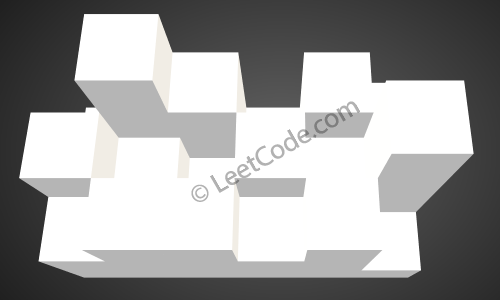
The above image represents the elevation map [[1,4,3,1,3,2],[3,2,1,3,2,4],[2,3,3,2,3,1]] before the rain.
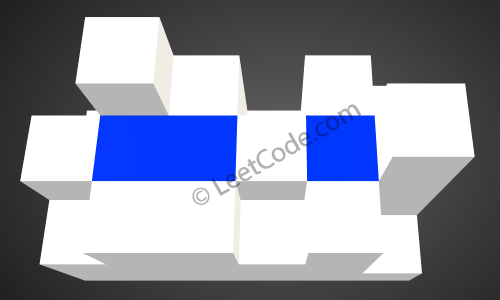
After the rain, water are trapped between the blocks. The total volume of water trapped is 4.
这道题是之前那道 Trapping Rain Water 的拓展,由 2D 变 3D 了,感觉很叼。但其实解法跟之前的完全不同了,之前那道题由于是二维的,我们可以用双指针来做,而这道三维的,我们需要用 BFS 来做,解法思路很巧妙,下面我们就以题目中的例子来进行分析讲解,多图预警,手机流量党慎入:
首先我们应该能分析出,能装水的底面肯定不能在边界上,因为边界上的点无法封闭,那么所有边界上的点都可以加入 queue,当作 BFS 的启动点,同时我们需要一个二维数组来标记访问过的点,访问过的点我们用红色来表示,那么如下图所示:
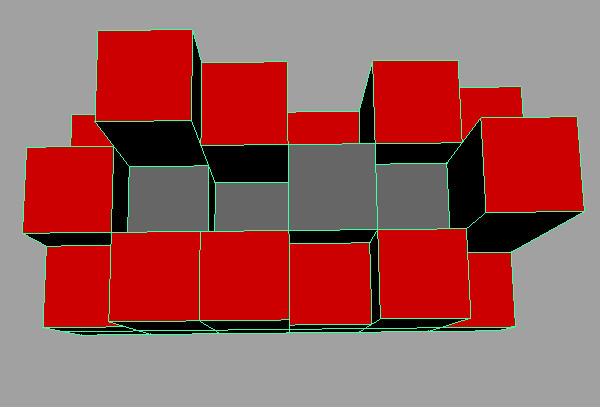
我们再想想,怎么样可以成功的装进去水呢,是不是周围的高度都应该比当前的高度高,形成一个凹槽才能装水,而且装水量取决于周围最小的那个高度,有点像木桶原理的感觉,那么为了模拟这种方法,我们采用模拟海平面上升的方法来做,我们维护一个海平面高度 mx,初始化为最小值,从1开始往上升,那么我们 BFS 遍历的时候就需要从高度最小的格子开始遍历,那么我们的 queue 就不能使用普通队列了,而是使用优先级队列,将高度小的放在队首,最先取出,这样我们就可以遍历高度为1的三个格子,用绿色标记出来了,如下图所示:

如上图所示,向周围 BFS 搜索的条件是不能越界,且周围格子未被访问,那么可以看出上面的第一个和最后一个绿格子无法进一步搜索,只有第一行中间那个绿格子可以搜索,其周围有一个灰格子未被访问过,将其加入优先队列 queue 中,然后标记为红色,如下图所示:
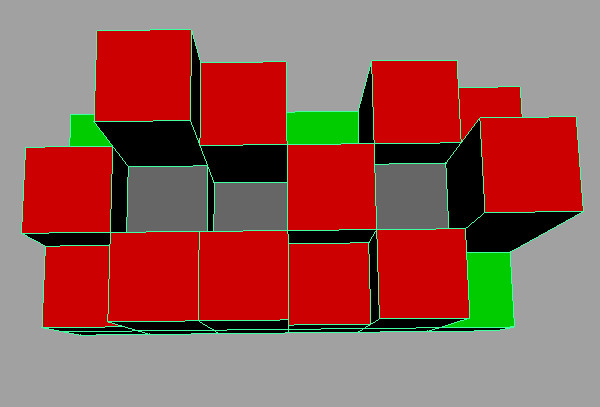
那么优先队列 queue 中高度为1的格子遍历完了,此时海平面上升1,变为2,此时我们遍历优先队列 queue 中高度为2的格子,有3个,如下图绿色标记所示:

我们发现这三个绿格子周围的格子均已被访问过了,所以不做任何操作,海平面继续上升,变为3,遍历所有高度为3的格子,如下图绿色标记所示:

由于我们没有特别声明高度相同的格子在优先队列 queue 中的顺序,所以应该是随机的,其实谁先遍历到都一样,对结果没啥影响,我们就假设第一行的两个绿格子先遍历到,那么那么周围各有一个灰格子可以遍历,这两个灰格子比海平面低了,可以存水了,把存水量算出来加入结果 res 中,如下图所示:
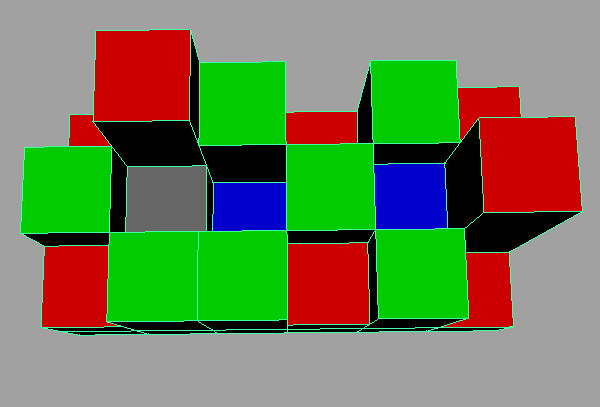
上图中这两个遍历到的蓝格子会被加入优先队列 queue 中,由于它们的高度小,所以下一次从优先队列 queue 中取格子时,它们会被优先遍历到,那么左边的那个蓝格子进行BFS搜索,就会遍历到其左边的那个灰格子,由于其高度小于海平面,也可以存水,将存水量算出来加入结果 res 中,如下图所示:

等两个绿格子遍历结束了,它们会被标记为红色,蓝格子遍历会先被标记红色,然后加入优先队列 queue 中,由于其周围格子全变成红色了,所有不会有任何操作,如下图所示:

此时所有的格子都标记为红色了,海平面继续上升,继续遍历完优先队列 queue 中的格子,不过已经不会对结果有任何影响了,因为所有的格子都已经访问过了,此时等循环结束后返回res即可,参见代码如下:
class Solution {
public:
int trapRainWater(vector<vector<int>>& heightMap) {
if (heightMap.empty()) return ;
int m = heightMap.size(), n = heightMap[].size(), res = , mx = INT_MIN;
priority_queue<pair<int, int>, vector<pair<int, int>>, greater<pair<int, int>>> q;
vector<vector<bool>> visited(m, vector<bool>(n, false));
vector<vector<int>> dir{{,-},{-,},{,},{,}};
for (int i = ; i < m; ++i) {
for (int j = ; j < n; ++j) {
if (i == || i == m - || j == || j == n - ) {
q.push({heightMap[i][j], i * n + j});
visited[i][j] = true;
}
}
}
while (!q.empty()) {
auto t = q.top(); q.pop();
int h = t.first, r = t.second / n, c = t.second % n;
mx = max(mx, h);
for (int i = ; i < dir.size(); ++i) {
int x = r + dir[i][], y = c + dir[i][];
if (x < || x >= m || y < || y >= n || visited[x][y]) continue;
visited[x][y] = true;
if (heightMap[x][y] < mx) res += mx - heightMap[x][y];
q.push({heightMap[x][y], x * n + y});
}
}
return res;
}
};
Github 同步地址:
https://github.com/grandyang/leetcode/issues/407
类似题目:
参考资料:
https://leetcode.com/problems/trapping-rain-water-ii/
https://leetcode.com/problems/trapping-rain-water-ii/discuss/89461/Java-solution-using-PriorityQueue
LeetCode All in One 题目讲解汇总(持续更新中...)
[LeetCode] 407. Trapping Rain Water II 收集雨水之二的更多相关文章
- [LeetCode] Trapping Rain Water II 收集雨水之二
Given an m x n matrix of positive integers representing the height of each unit cell in a 2D elevati ...
- [LeetCode] 407. Trapping Rain Water II 收集雨水 II
Given an m x n matrix of positive integers representing the height of each unit cell in a 2D elevati ...
- [leetcode] 407. Trapping Rain Water II
https://leetcode.com/contest/6/problems/trapping-rain-water-ii/ 看到这题,我很高兴,因为我做过!哈哈!其实我现在也写不出来,知道大概思想 ...
- leetcode 11. Container With Most Water 、42. Trapping Rain Water 、238. Product of Array Except Self 、407. Trapping Rain Water II
11. Container With Most Water https://www.cnblogs.com/grandyang/p/4455109.html 用双指针向中间滑动,较小的高度就作为当前情 ...
- 407. Trapping Rain Water II
Given an m x n matrix of positive integers representing the height of each unit cell in a 2D elevati ...
- 407 Trapping Rain Water II 接雨水 II
给定一个m x n的矩阵,其中的值均为正整数,代表二维高度图每个单元的高度,请计算图中形状最多能接多少体积的雨水.说明:m 和 n 都是小于110的整数.每一个单位的高度都大于0 且小于 20000. ...
- [LeetCode] 42. Trapping Rain Water 收集雨水
Given n non-negative integers representing an elevation map where the width of each bar is 1, comput ...
- leetcode#42 Trapping rain water的五种解法详解
leetcode#42 Trapping rain water 这道题十分有意思,可以用很多方法做出来,每种方法的思想都值得让人细细体会. 42. Trapping Rain WaterGiven n ...
- [array] leetcode - 42. Trapping Rain Water - Hard
leetcode - 42. Trapping Rain Water - Hard descrition Given n non-negative integers representing an e ...
随机推荐
- Ubuntu sudo 免密码
sudo visudo 这里默认打开的是 nano 编辑器,不习惯可以把默认编辑器换成 vim, 参考 Ubuntu 修改默认编辑器 test ALL=NOPASSWD: ALL
- Java连载41-this关键字其他注意事项、static方法
一.this关键字 1.this在多数情况下都会省略 2.this不能用在含有static的方法之中. 3.static的方法的调用是不需要对象的,直接使用格式:类名.方法名:没有当前对象,自然不能访 ...
- 用OC实现双向链表:构造链表、插入节点、删除节点、遍历节点
一.介绍 双向链表:每一个节点前后指针域都和它的上一个节点互相指向,尾节点的next指向空,首节点的pre指向空. 二.使用 注:跟单链表差不多,简单写常用的.循环链表无法形象化打印,后面也暂不实现了 ...
- 定时锁屏程序,Python祝你原理猝死!
高以翔事件 11月27日在<追我吧>第九期节目的录制过程中,当期参与嘉宾高以翔奔跑时突然减速倒地,节目现场医护人员第一时间展开救治,并紧急将其送往医院.经过两个多小时的全力抢救,医院最终宣 ...
- 新安装ubuntu系统的简单优化
新安装的ubuntu系统,需要做下简单的优化,使其符合常用习惯,优化过程的命令与centos大都不一致,撰文备份,以备所需: 1.获取ubuntu系统root权限 在终端输入sudo passwd r ...
- IT兄弟连 Java语法教程 流程控制语句 分支结构语句3
3 if-else if-else条件语句 if-else if-else的完整形式如下: if(判断条件A){ A语句块(判断条件A的值为true,执行) }else if(判断条件B){ B语句 ...
- Ansible-Tower自动化运维管理环境 - 安装破解记录
公司中实现运维自动化的架构中主要用到ansible,ansible脚本在部署服务器指令行中显得不太直观.Ansible-Tower(之前叫做awx)是将ansible的指令界面化,简明直观,简单易用. ...
- Java设计模式:Singleton(单例)模式
概念定义 Singleton(单例)模式是指在程序运行期间, 某些类只实例化一次,创建一个全局唯一对象.因此,单例类只能有一个实例,且必须自己创建自己的这个唯一实例,并对外提供访问该实例的方式. 单例 ...
- mysqlslap详解--MySQL自带的性能压力测试工具(转)
本文的参考博客地址为:https://blog.csdn.net/fuzhongfaya/article/details/80943991 和 https://www.cnblogs.com/davy ...
- JavaEE之Hibernate(开放源代码的对象关系映射框架)
Hibernate(开放源代码的对象关系映射框架) 1.简介 Hibernate是一个开放源代码的对象关系映射框架,它对JDBC进行了非常轻量级的对象封装,它将POJO与数据库表建立映射关系,是一个全 ...
